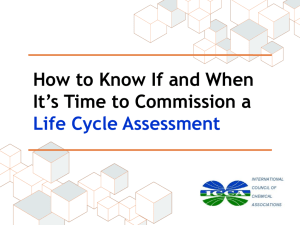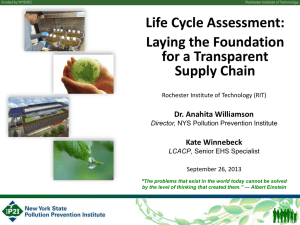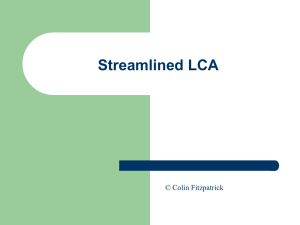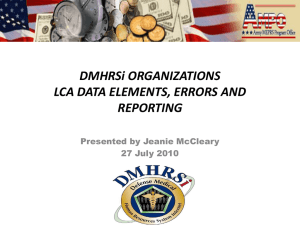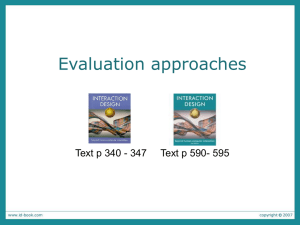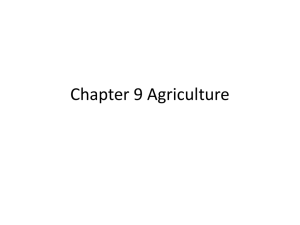Module a - LCA and decision support
advertisement
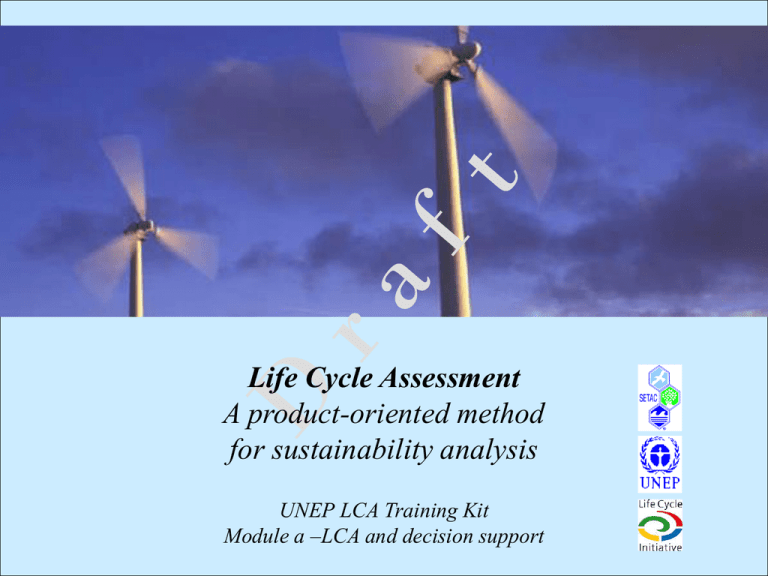
Life Cycle Assessment A product-oriented method for sustainability analysis UNEP LCA Training Kit Module a –LCA and decision support 1 Content • • • • • Demand for environmental information Supply of environmental information Examples of environmental information Survey of analytical tools LCA – main characteristics – main applications – main limitations and how to solve them – LCA and certification 2 2 Demand for environmental information (1) • Possible objects of decision making – substance, material – product, service – waste, waste management – process, installation – activity, project, building, infrastructure – company – technology – societal sector – life style – … 3 3 Demand for environmental information (2) • Types of decision situations – strategic planning and capital investments (green building, waste management) – eco-design, product development – operational management (green procurement) – communication and marketing (eco-labelling, product information) 4 4 Demand for environmental information (3) • Spatial requirements – local (site specific) – regional (site dependent) – global (generic) • Temporal requirements – snapshot – steady state / comparative static – (quasi) dynamic 5 5 Demand for environmental information (4) • Complex decision situations, yet simple information required – simple indicators – visualization – aggregation – weighting • Simple format for final presentation 6 6 Supply of environmental information (1) Concepts Decision process Analytical tools implementation policy instruments Procedural tools Content: technical elements / basic equations / data 7 7 Supply of environmental information (2) • Concepts – life cycle thinking / life cycle management (LCM) – design for environment (DfE) – cleaner technology – green chemistry – dematerialisation – industrial ecology / industrial metabolism – end of life management – eco-efficiency (or analytical tool?) – … 8 8 Supply of environmental information (3) • Decision process, policy instruments and implementation – direct implementation of activities – legal instruments (physical regulation) – financial instruments – communication instruments (e.g., environmental labelling (= eco-labelling) 9 9 Supply of environmental information (5) • Analytical tools – physical metrics • environmental risk assessment (ERA), life cycle assessment (LCA), material flow analysis (MFA), energy analysis, ecological footprint, … – monetary metrics • cost benefit analysis (CBA), total cost analysis (TCA), life cycle costing (LCC), input-output analysis (IOA), … 10 10 Supply of environmental information (6) • Procedural tools – in-company management systems • quality management systems (EHS), environmental management systems (EMAS, EMS), environmental audit, … – permits • environmental impact assessment (EIA), environmental license, … – others • green procurement, voluntary agreements between stakeholders, … 11 11 Supply of environmental information (7) • Content – technical elements / basic equations • mass balance models, dispersion models, dose-effect relationships, market behavior, uncertainty analysis, multicriteria analysis, … – data • sectoral emissions, product composition, chemical persistence, LC50, income elasticity, … 12 12 Supply of environmental information (8) • Empirical information on the relations between noise levels and the presence of birds Supply of environmental information (9) impact • Quasi-empirical information on the relation between the concentration of a chemical and the impact on organisms NOEC LC50 log concentration 14 14 Examples of environmental information (1) Source: http://www.pg.com/content/pdf/01_about_pg/corporate_citizenship/sustainability/reports/CBR_ProcterGamble_061.pdf Examples of environmental information (2) Source: http://corporate.basf.com/en/sustainability/ Examples of environmental information (3) http://www.clw.csiro.au/publications/technical2005/tr1-05.pdf Examples of environmental information (4) • Ecolabeling – criteria based on life-cycle considerations – just a few examples Survey of analytical tools (1) • Tools in physical metrics – checklists and matrices – risk-based tools – tools for product and service systems – regional tools • Tools in monetary metrics 19 19 Survey of analytical tools - checklists • Checklists and matrices Criterion 1: critical resources Criterion 2: CO2 emissions Criterion 3: hazardous emissions Alternative 1 --- - --- Alternative 2 0 --- - Alternative 3 0 ++ -- 20 20 Survey of analytical tools –risk-based tools (1) • Risk-based tools – Risk Analysis (RA) – Environmental Risk Assessment (ERA) 21 21 Survey of analytical tools –risk-based tools (2) • Risk analysis – for assessing the risk of incidents and calamities – focus on human health, or broader – local, or broader – typically for large industrial installations – risk analysis vs. risk perception – risk = chance effect 22 22 Survey of analytical tools –risk-based tools (3) Survey of analytical tools –risk-based tools (4) • Environmental risk assessment (ERA) – for assessing the risk of regular emissions – focus on emission of and exposure to toxic substances – focus on risk to ecosystems but also for human health (HERA) – risk characterisation ratio: PEC/PNEC 24 24 Survey of analytical tools –risk-based tools (5) Survey of analytical tools –risk-based tools (6) Survey of analytical tools –risk-based tools (7) • Use of (H)ERA – admission of chemicals – prioritizing substance policy • Non-use of (H)ERA – drinking water quality – food quality 27 27 Survey of analytical tools – tools for product and service systems (1) • Tools for product and service systems – Life Cycle Assessment (LCA) – Total Material Requirement (TMR), Material Input per Unit of Service (MIPS) – Energy analysis/cumulative energy demand (CED) 28 28 Survey of analytical tools – tools for product and service systems (2) • Life cycle assessment (LCA) – focus on comparison of products with similar functions – from the cradle to the grave – covering a wide range of environmental aspects • impacts on human health (climate change, ozone depletion, smog, toxicity, etc.) • impacts on ecosystem quality (acidification, eutrophication, toxicity, etc.) • impacts on resource availability (depletion of minerals, fossil fuels, etc.) 29 29 Survey of analytical tools – tools for product and service systems (3) Source: http://www.fibersource.com/f-tutor/LCA-Page.htm Survey of analytical tools – tools for product and service systems (4) • Total Material Requirement (TMR), Material Input / Unit of Service (MIPS) – focus on mass-flow input only (total mass input per functional unit) – including “rucksacks” – what is the “weight” of a golden ring? – focus on global, steady state 31 31 Survey of analytical tools – tools for product and service systems (5) • Energy analysis/cumulative energy demand (CED) – focuses on (fossil) energy input – also objective to produce encompassing indicator for total environmental burden – objects can be product systems or regions ( regional tool) – focus on global, steady state – used for, e.g., support of climate policy or resource strategy 32 32 Survey of analytical tools – regional tools (1) • Regional tools – Material Flow Analysis (MFA) • for economy of a region, without rucksacks • for economy of a region, with rucksacks (cf. MIPS) – Substance Flow Analysis (SFA) • for region, with economy and environment as subsystems – Ecological Footprint (EF) 33 33 Survey of analytical tools – regional tools (2) • Material Flow Analysis (MFA) – material balance for economy of a region (in kg) (or country) • focus: for a given year – if with rucksacks, then functional approach ( MIPS) – for economy: in = out + accumulation – potential relevance at regional level as indicator for dematerialisation – typical applications: • comparisons between countries or large economic sectors • changes over time for countries or sectors 34 34 Survey of analytical tools – regional tools (3) • Basic template – TMR = total material requirement – DMI = domestic material input Survey of analytical tools – regional tools (5) • Substance Flow Analysis (SFA) – Flows of single substances through economy and potentially environment of a region • typical examples: N, P, heavy metals (Cd, Hg, Pt, In, others) • focus on regions of any size • focus on results for a given year – Typical results: • origin analysis of problem flows to environment • risks of unnoticed accumulations in economy • potentials of urban mining • risks of unintended inflows – Typical application: • for support of substance policies 36 36 Draf t Survey of analytical tools – regional tools (6) Survey of analytical tools – tools for product and service systems (5) • Ecological footprint – aim: to express the total environmental pressure in terms of space consumption (in hectare or square meters) – for hazardous substances: dilution up to thresholds – for energy: biomass production – focus on global, steady state • Status: – large policy support, but scientifically debated 38 38 Survey of analytical tools – tools in monetary metrics (1) • Cost-Benefit Analysis (CBA) • Input-Output Analysis (IOA) • Life Cycle Costing (LCC)/Total Cost Accounting (TCA) 39 39 Survey of analytical tools – tools in monetary metrics (2) • Cost-benefit analysis (CBA) – for a single activity – all impacts expressed in monetary terms (using several methods, particularly WtP) – high policy profile, many applications – severely criticised by environmental scientists because of under-representation of ecological damage – focus: local, steady state • Typical application: support of decisions on governmental investment activities (e.g., infrastructure, waste management) 40 40 Survey of analytical tools – tools in monetary metrics (3) • Input-output analysis (IOA) – established tool (Leontief, 1930-ies, Nobel prize 1973) – monetary flows between economic sectors – what are consequences of specific investment (policy change) in one specific sector? – focus: national level, given year • Environmental IOA (EIOA) – environmental extensions (“satellites”) • Typical application: prioritization regarding policy support of different economic sectors 41 41 Survey of analytical tools – tools in monetary metrics (4) • Life cycle costing (LCC)/Total cost accounting (TCA) – LCA in monetary terms (same structure; global level, steady state) – aims to quantify hidden costs over the life cycle (risk management, waste management, communication, illnesses, etc.) – can have two forms: • including (monetised) environmental impacts • excluding environmental impacts • Typical application: to be used in conjunction with LCA – or even integrated with LCA in eco-efficiency 42 42 Life Cycle Assessment (1) • Life cycle assessment (LCA) – product from cradle to grave (vertical integration) • total picture; avoidance of problem shifting – all types of impact (horizontal integration) – role of functional unit • for comparability of different product systems – integration over space and time – standardised in ISO (14040 series) 43 43 Life Cycle Assessment (2) L ife c yc le a s s e s s m e n t fra m e w o rk G oal a n d s co p e d e fin itio n D ire c t a p p lic a tio n s : - P ro d u c t d e ve lo p m e n t a n d im p ro ve m e n t - S tra te g ic p la n n in g - P u b lic p o lic y m a k in g - M a rk e tin g - O th e r In ve n to r y a n a lys is In te rp re ta tio n Im p a c t a s s e ss m e n t Source: ISO 14040 44 44 Life Cycle Assessment (3) • Final result can be in terms of: – LCI results (extractions and emissions) – LCIA results (for separate impact categories) – weighted results (one index) • Weighting (subjective!) possible on basis of: – distance to target (policy reference) – economic values (various possibilities, incl. collectively revealed preferences) – social preferences (panel process) 45 45 • Example of the results of a comparative LCA Draf t Life Cycle Assessment (4) Impact category Incandescent lamp Fluorescent lamp Climate change 120000 kg CO2-eq 40000 kg CO2-eq Ecotoxicity 320 kg DCB-eq 440 kg DCB-eq Acidification 45 kg SO2-eq 21 kg SO2-eq Depletion of resources 0.8 kg antinomy-eq 0.3 kg antinomy-eq etc … … 46 46 Life Cycle Assessment (5) • Main applications – product comparisons – product improvement, design and development – strategy and policy development – LCA as a process 47 47 Life Cycle Assessment – main applications (1) • Product comparisons – by industry, government, NGOs – also for ecolabeling (type I, type III) • Note: – need for authorized procedure and peer review – “comparative assertions disclosed to the public” (ISO) 48 48 Life Cycle Assessment – main applications (2) Draf t 49 49 Life Cycle Assessment – main applications (3) • Product improvement, design and development – by industry – also on the basis of adapted LCA-tools • Learning curve: – LCA suggests rules of thumb – rules of thumb further validated and improved by LCA 50 50 Life Cycle Assessment – main applications (4) e n v iro n m e n ta l im p ro v e m e n t (fa c to rs ) L e ve l o f im p ro ve m e n t 25 S ys te m In n o va tio n 20 15 10 F u n c tio n a l In n o va tio n 5 R e d e s ig n 0 0 10 20 30 40 50 60 tim e (y e a rs ) 51 51 Life Cycle Assessment – main applications (5) 52 52 Life Cycle Assessment – main applications (6) • Policy and policy development – by government, sometimes together with industries or NGOs – examples: • waste management • packaging • EU's Integrated Product Policy (IPP) • energy policy • green building 53 53 Life Cycle Assessment – main applications (7) 54 54 Life Cycle Assessment – main applications (7) 55 55 Life Cycle Assessment – main applications (8) • LCA as a process – LCA as a vehicle of discussion for various stakeholders • producer • supply chain • competitors • purchasers • government • NGOs 56 56 Life Cycle Assessment – main limitations (1) • LCA in practice obstructed by: – data requirements – methodological inconsistencies – technical characteristics 57 57 Life Cycle Assessment – main limitations (2) • Data requirements – only general, no specific data – obsolete data – only data from industrialized countries – different data formats – databases not connected • Role for ISO 14048 and UNEP/SETAC Life Cycle Initiative • Role for input-output analysis (and hybrids of IOA and LCA) 58 58 Life Cycle Assessment – main limitations (3) • Methodological inconsistencies and debates: – main issues in LCI: • system boundaries • multiple processes/allocation • attribution versus change oriented – main issues in LCIA • midpoint versus damage level • heterogeneous mechanisms (e.g., toxicity) • regionalisation 59 59 Life Cycle Assessment – technical characteristics (1) • Some specific details: – global/regional, not local – steady state, not dynamic, no one-time transitions – quantitative, not pass/fail criteria – risk approach, not prevention approach 60 60 Life Cycle Assessment – technical characteristics (2) • Usual impact categories: – depletion of fossil fuels and minerals – climate change – ozone depletion – photo-oxidant formation – acidification – eutrophication – human toxicity and ecotoxicity 61 61 Life Cycle Assessment – technical characteristics (3) • Potential impact categories: – land occupation (area) – water use – salination – soil erosion – leakage of nutrients – noise 62 62 Life Cycle Assessment – technical characteristics (4) • Not fitting impact categories: – land use quality (forest, coral reefs) – depletion of wildlife and fish stocks – desiccation; desertification – biodiversity – contained toxics 63 63 Life Cycle Assessment – technical characteristics (5) • Need to make LCA – broader (more impacts, also covering economic and social aspects) – deeper (more precise, more mechanisms) • How to make LCA broader and deeper – three major options: • extension of LCA • hybrid LCA • use of toolbox (with additional quantitative tools, or using pass-fail criteria) 64 64 Pass-fail criteria – black lists • Some examples: – substances contained in products (lead in pencils; Cl in PVC; plastic weakeners in toys) – substances contained in manufacturing processes (phosgene for PET production, isocyanate for polyurethane production) 65 65 Pass-fail criteria – certification • Used for companies (ISO 14001) • Also for natural resources: – use of criteria – can be included in life cycle approach • Many examples: – forestry – fishery – agriculture – mining 66 66 Certification - sustainable forestry (1) • The problems: – net loss 1980-1995: 12 mln ha / year – decline in developing world, increase in industrialised world – drivers: timber and land for agriculture 67 67 Certification - sustainable forestry (2) • Two types of certification: – forestry management – chain of custody • Forest Stewardship Council (FSC) – 1993, others followed – now 6 global organisations with 3rd party review • Effective through large companies (lumber retailers, manufacturers, retailers), not through individual consumers • Reasons: good image and sustainable business, not large financial interest 68 68 Certification - sustainable forestry (3) Area certified forest 250 200 milion ha MTCC 150 CSA ATFS SFI PEFC 100 FSC 50 0 2000 2001 2002 2003 2004 69 69 Certification - sustainable forestry (4) • Requirements for certificate – existence of management plan – restoration of natural forest – diversity in tree species and age classes – preference for native species – part of plantation managed as natural forest – soil and water conservation – integrated pest management – monitoring of ecological and social impacts – no change of natural forest after 1994 70 70 Certification - sustainable fishery (1) • The problems: – fish provides 40% of protein in developing countries – fishing down the food chain; peak in 1989 – tragedy of the commons – improving technology, larger distances – by-catch (30-70%), thrown over board – damage to marine habitats (coral reefs, sea mounts) 71 71 Certification - sustainable fishery (2) • Marine Stewardship Council (MSC) – initiative Unilever and WWF, 1997 • Criteria setting by fishermen, fisheries managers, seafood processors, retailers, scientists and NGOs • Certificates deal with fish stocks and fishing methods • Role of fishermen collectives • Life cycle perspective: chain of custody certification • Next step: also certification of aquaculture? 72 72 Certification - sustainable fishery (3) • Criteria: – healthy fish stock – sustainable harvest – ecosystem integrity – minimisation of by-catch – clear rules and procedures – compliance with existing laws 73 73 Certification - sustainable agriculture (1) • Organic versus current agriculture – since 1927 • Limitations regarding space requirements • Better perspectives for integrated or sustainable agriculture – minimisation use of pesticides – wise use of fertilizers – enhancement of biodiversity • Since 2002 Sustainable Agriculture Initiative – global platform of companies in food chain, started by Unilever, Nestlé and Danone 74 74 Certification - sustainable mining (1) • The problems: – huge environmental impacts of extraction of fossil fuels and minerals • Not yet certificates more sustainable performing companies – for fossil fuels: Chevron, BP, Shell – for minerals: Rio Tinto • In progress: sustainable mining project of ICMM 75 75 Certification and LCA • Double relationship to LCA – LCA and certification completely different worlds – but mutual support is advisable: • LCA can support certification for “its own” impact categories (climate change, etc.) • certification can provide information for new LCA impact category: amount of (non-) certified resources per functional unit 76 76 Conclusions • LCA well developed, high profile tool – developments mainly at harmonization – broad spectrum of applications • Also number of clear limitations, no “super tool” – strong need for additional tools, also in life cycle context • Mutual support advisable between LCA and certification 77 77
